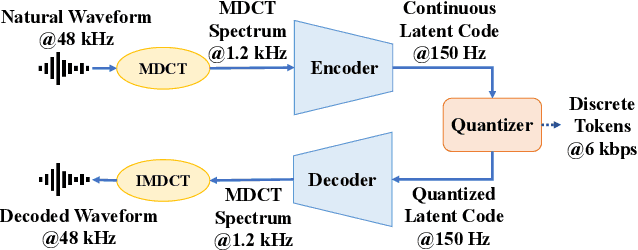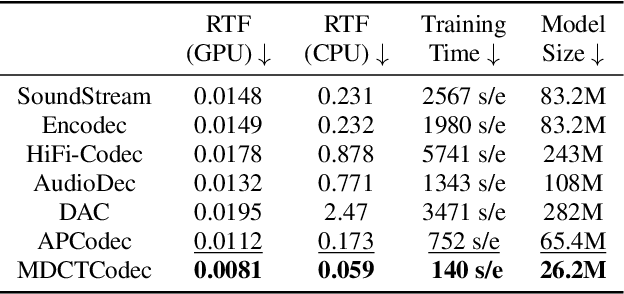Rui-Chen Zheng
Say More with Less: Variable-Frame-Rate Speech Tokenization via Adaptive Clustering and Implicit Duration Coding
Sep 04, 2025Abstract:Existing speech tokenizers typically assign a fixed number of tokens per second, regardless of the varying information density or temporal fluctuations in the speech signal. This uniform token allocation mismatches the intrinsic structure of speech, where information is distributed unevenly over time. To address this, we propose VARSTok, a VAriable-frame-Rate Speech Tokenizer that adapts token allocation based on local feature similarity. VARSTok introduces two key innovations: (1) a temporal-aware density peak clustering algorithm that adaptively segments speech into variable-length units, and (2) a novel implicit duration coding scheme that embeds both content and temporal span into a single token index, eliminating the need for auxiliary duration predictors. Extensive experiments show that VARSTok significantly outperforms strong fixed-rate baselines. Notably, it achieves superior reconstruction naturalness while using up to 23% fewer tokens than a 40 Hz fixed-frame-rate baseline. VARSTok further yields lower word error rates and improved naturalness in zero-shot text-to-speech synthesis. To the best of our knowledge, this is the first work to demonstrate that a fully dynamic, variable-frame-rate acoustic speech tokenizer can be seamlessly integrated into downstream speech language models. Speech samples are available at https://zhengrachel.github.io/VARSTok.
Is GAN Necessary for Mel-Spectrogram-based Neural Vocoder?
Aug 11, 2025Abstract:Recently, mainstream mel-spectrogram-based neural vocoders rely on generative adversarial network (GAN) for high-fidelity speech generation, e.g., HiFi-GAN and BigVGAN. However, the use of GAN restricts training efficiency and model complexity. Therefore, this paper proposes a novel FreeGAN vocoder, aiming to answer the question of whether GAN is necessary for mel-spectrogram-based neural vocoders. The FreeGAN employs an amplitude-phase serial prediction framework, eliminating the need for GAN training. It incorporates amplitude prior input, SNAKE-ConvNeXt v2 backbone and frequency-weighted anti-wrapping phase loss to compensate for the performance loss caused by the absence of GAN. Experimental results confirm that the speech quality of FreeGAN is comparable to that of advanced GAN-based vocoders, while significantly improving training efficiency and complexity. Other explicit-phase-prediction-based neural vocoders can also work without GAN, leveraging our proposed methods.
Vision-Integrated High-Quality Neural Speech Coding
May 29, 2025Abstract:This paper proposes a novel vision-integrated neural speech codec (VNSC), which aims to enhance speech coding quality by leveraging visual modality information. In VNSC, the image analysis-synthesis module extracts visual features from lip images, while the feature fusion module facilitates interaction between the image analysis-synthesis module and the speech coding module, transmitting visual information to assist the speech coding process. Depending on whether visual information is available during the inference stage, the feature fusion module integrates visual features into the speech coding module using either explicit integration or implicit distillation strategies. Experimental results confirm that integrating visual information effectively improves the quality of the decoded speech and enhances the noise robustness of the neural speech codec, without increasing the bitrate.
MDCTCodec: A Lightweight MDCT-based Neural Audio Codec towards High Sampling Rate and Low Bitrate Scenarios
Nov 01, 2024



Abstract:In this paper, we propose MDCTCodec, an efficient lightweight end-to-end neural audio codec based on the modified discrete cosine transform (MDCT). The encoder takes the MDCT spectrum of audio as input, encoding it into a continuous latent code which is then discretized by a residual vector quantizer (RVQ). Subsequently, the decoder decodes the MDCT spectrum from the quantized latent code and reconstructs audio via inverse MDCT. During the training phase, a novel multi-resolution MDCT-based discriminator (MR-MDCTD) is adopted to discriminate the natural or decoded MDCT spectrum for adversarial training. Experimental results confirm that, in scenarios with high sampling rates and low bitrates, the MDCTCodec exhibited high decoded audio quality, improved training and generation efficiency, and compact model size compared to baseline codecs. Specifically, the MDCTCodec achieved a ViSQOL score of 4.18 at a sampling rate of 48 kHz and a bitrate of 6 kbps on the public VCTK corpus.
APCodec+: A Spectrum-Coding-Based High-Fidelity and High-Compression-Rate Neural Audio Codec with Staged Training Paradigm
Oct 30, 2024Abstract:This paper proposes a novel neural audio codec, named APCodec+, which is an improved version of APCodec. The APCodec+ takes the audio amplitude and phase spectra as the coding object, and employs an adversarial training strategy. Innovatively, we propose a two-stage joint-individual training paradigm for APCodec+. In the joint training stage, the encoder, quantizer, decoder and discriminator are jointly trained with complete spectral loss, quantization loss, and adversarial loss. In the individual training stage, the encoder and quantizer fix their parameters and provide high-quality training data for the decoder and discriminator. The decoder and discriminator are individually trained from scratch without the quantization loss. The purpose of introducing individual training is to reduce the learning difficulty of the decoder, thereby further improving the fidelity of the decoded audio. Experimental results confirm that our proposed APCodec+ at low bitrates achieves comparable performance with baseline codecs at higher bitrates, thanks to the proposed staged training paradigm.
ERVQ: Enhanced Residual Vector Quantization with Intra-and-Inter-Codebook Optimization for Neural Audio Codecs
Oct 16, 2024Abstract:Current neural audio codecs typically use residual vector quantization (RVQ) to discretize speech signals. However, they often experience codebook collapse, which reduces the effective codebook size and leads to suboptimal performance. To address this problem, we introduce ERVQ, Enhanced Residual Vector Quantization, a novel enhancement strategy for the RVQ framework in neural audio codecs. ERVQ mitigates codebook collapse and boosts codec performance through both intra- and inter-codebook optimization. Intra-codebook optimization incorporates an online clustering strategy and a code balancing loss to ensure balanced and efficient codebook utilization. Inter-codebook optimization improves the diversity of quantized features by minimizing the similarity between successive quantizations. Our experiments show that ERVQ significantly enhances audio codec performance across different models, sampling rates, and bitrates, achieving superior quality and generalization capabilities. It also achieves 100% codebook utilization on one of the most advanced neural audio codecs. Further experiments indicate that audio codecs improved by the ERVQ strategy can improve unified speech-and-text large language models (LLMs). Specifically, there is a notable improvement in the naturalness of generated speech in downstream zero-shot text-to-speech tasks. Audio samples are available here.
Stage-Wise and Prior-Aware Neural Speech Phase Prediction
Oct 07, 2024



Abstract:This paper proposes a novel Stage-wise and Prior-aware Neural Speech Phase Prediction (SP-NSPP) model, which predicts the phase spectrum from input amplitude spectrum by two-stage neural networks. In the initial prior-construction stage, we preliminarily predict a rough prior phase spectrum from the amplitude spectrum. The subsequent refinement stage transforms the amplitude spectrum into a refined high-quality phase spectrum conditioned on the prior phase. Networks in both stages use ConvNeXt v2 blocks as the backbone and adopt adversarial training by innovatively introducing a phase spectrum discriminator (PSD). To further improve the continuity of the refined phase, we also incorporate a time-frequency integrated difference (TFID) loss in the refinement stage. Experimental results confirm that, compared to neural network-based no-prior phase prediction methods, the proposed SP-NSPP achieves higher phase prediction accuracy, thanks to introducing the coarse phase priors and diverse training criteria. Compared to iterative phase estimation algorithms, our proposed SP-NSPP does not require multiple rounds of staged iterations, resulting in higher generation efficiency.
Incorporating Ultrasound Tongue Images for Audio-Visual Speech Enhancement
Sep 19, 2023Abstract:Audio-visual speech enhancement (AV-SE) aims to enhance degraded speech along with extra visual information such as lip videos, and has been shown to be more effective than audio-only speech enhancement. This paper proposes the incorporation of ultrasound tongue images to improve the performance of lip-based AV-SE systems further. To address the challenge of acquiring ultrasound tongue images during inference, we first propose to employ knowledge distillation during training to investigate the feasibility of leveraging tongue-related information without directly inputting ultrasound tongue images. Specifically, we guide an audio-lip speech enhancement student model to learn from a pre-trained audio-lip-tongue speech enhancement teacher model, thus transferring tongue-related knowledge. To better model the alignment between the lip and tongue modalities, we further propose the introduction of a lip-tongue key-value memory network into the AV-SE model. This network enables the retrieval of tongue features based on readily available lip features, thereby assisting the subsequent speech enhancement task. Experimental results demonstrate that both methods significantly improve the quality and intelligibility of the enhanced speech compared to traditional lip-based AV-SE baselines. Moreover, both proposed methods exhibit strong generalization performance on unseen speakers and in the presence of unseen noises. Furthermore, phone error rate (PER) analysis of automatic speech recognition (ASR) reveals that while all phonemes benefit from introducing ultrasound tongue images, palatal and velar consonants benefit most.
Incorporating Ultrasound Tongue Images for Audio-Visual Speech Enhancement through Knowledge Distillation
May 24, 2023Abstract:Audio-visual speech enhancement (AV-SE) aims to enhance degraded speech along with extra visual information such as lip videos, and has been shown to be more effective than audio-only speech enhancement. This paper proposes further incorporating ultrasound tongue images to improve lip-based AV-SE systems' performance. Knowledge distillation is employed at the training stage to address the challenge of acquiring ultrasound tongue images during inference, enabling an audio-lip speech enhancement student model to learn from a pre-trained audio-lip-tongue speech enhancement teacher model. Experimental results demonstrate significant improvements in the quality and intelligibility of the speech enhanced by the proposed method compared to the traditional audio-lip speech enhancement baselines. Further analysis using phone error rates (PER) of automatic speech recognition (ASR) shows that palatal and velar consonants benefit most from the introduction of ultrasound tongue images.
Speech Reconstruction from Silent Tongue and Lip Articulation By Pseudo Target Generation and Domain Adversarial Training
Apr 12, 2023Abstract:This paper studies the task of speech reconstruction from ultrasound tongue images and optical lip videos recorded in a silent speaking mode, where people only activate their intra-oral and extra-oral articulators without producing sound. This task falls under the umbrella of articulatory-to-acoustic conversion, and may also be refered to as a silent speech interface. We propose to employ a method built on pseudo target generation and domain adversarial training with an iterative training strategy to improve the intelligibility and naturalness of the speech recovered from silent tongue and lip articulation. Experiments show that our proposed method significantly improves the intelligibility and naturalness of the reconstructed speech in silent speaking mode compared to the baseline TaLNet model. When using an automatic speech recognition (ASR) model to measure intelligibility, the word error rate (WER) of our proposed method decreases by over 15% compared to the baseline. In addition, our proposed method also outperforms the baseline on the intelligibility of the speech reconstructed in vocalized articulating mode, reducing the WER by approximately 10%.
 Add to Chrome
Add to Chrome Add to Firefox
Add to Firefox Add to Edge
Add to Edge